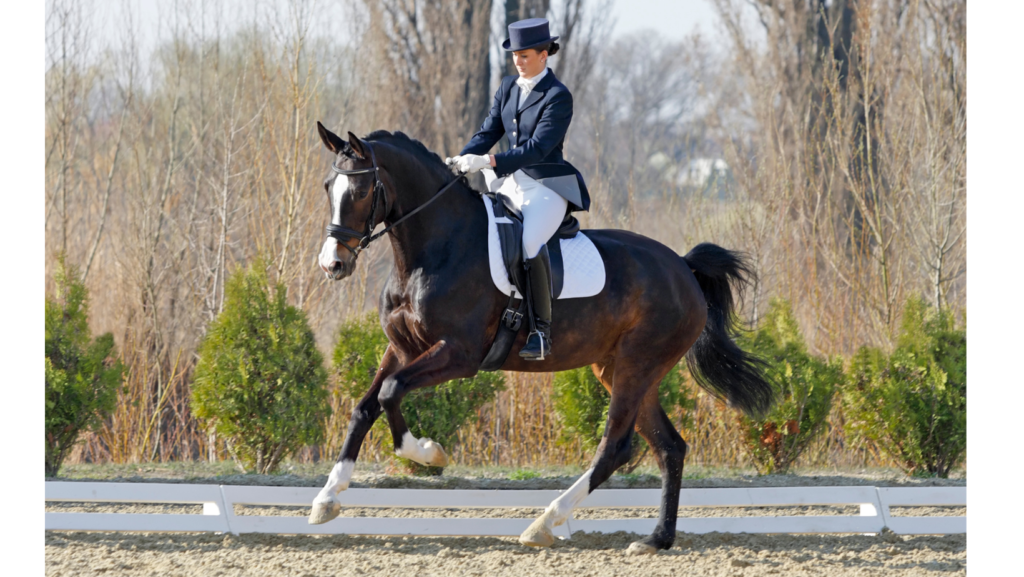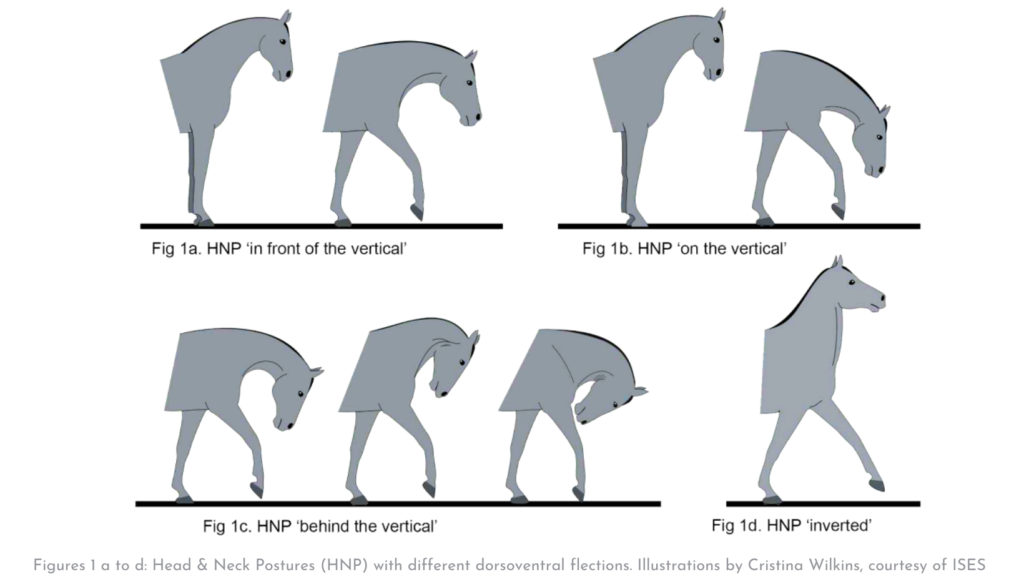VI. DRESSAGE
PARIS ‘24 HORSE WELFARE CAMPAIGN
“The welfare of Olympic horses should no longer be overlooked and neglected”
This blog is an excerpt from the PARIS 2024 HORSE WELFARE CAMPAIGN MAGAZINE which is free to download and read online.

Photo Canva: “The nose must always be in front of the vertical”
From riders, groups and animal protection associations a large number of people are increasingly voicing their denunciation of the hyperflexion of the neck imposed on horses, which is harmful medically and on welfare grounds.
Hyperflexion is a head and neck posture that is imposed by the hands of the rider via the reins, where the horse curls the neck placing the nose line behind the vertical.
This posture is unnatural, disturbs the balance, vision, and breathing of the horse, and induces stress and physical suffering. Studies carried out over the last 15 years conclude that the effect on performance is lacking (74%) and the practice is detrimental to the horse’s welfare (88%), and these percentages are still increasing in view of the most recent studies, such as Kienapfel et al. November 2021.
The negative effects of hyperflexion are documented: restriction of the field of vision, contraction of the head-neck balance, the consequent reduction in the diameter of the pharynx, significant difficulty in breathing and swallowing, obstructed jaw, lack of relaxation, signs of discomfort and conflict behaviour, post-inhibitory rebound, hyper submission, learned helplessness, reduction in the horse’s ability to learn, trauma (in particular to the nuchal region and the nuchal ligament), decreased mobility in the lumbar region, even locking up, compression of the vertebral bodies and intervertebral discs, increased cortisol (stress), restriction of breathing, change in back mechanics and pathologies of the forelimb and feet, blood circulation of the tongue impeded by the pressure of the bit (blue tongue).
In addition, horses whose training is based on hyperflexion, show a denaturation of gaits, in particular a loss of diagonalization in the trot, passage and piaffe. The walk becomes lateral. They are unable to maintain a halt correctly, nor do they keep the poll as the highest point of the neck; the neck ‘breaks’, and the 2nd or 3rd vertebra becomes the highest point in collected gaits and movements. Often, these horses struggle to maintain the nose in front of the vertical during the dressage test.
The nose must always be in front of the vertical whatever the type of work requested:
- at its highest posture, the neck flexion is correct if the neck is extended, the jowl open, and the nose remaining in front of the vertical;
- in lower postures, when ‘giving to the bit’, the right posture or outline is when the poll is the highest point, and the nose is on, or in front of the vertical.
Hyperflexion, on the other hand, is always harmful and is described using various names:

Photo on the left (above), the LDR (Low/Long, Deep and Round, in French “low and round”); Photo: Canva
Centre photo (above), the rollkur, which is the extreme form of hyperflexion; Photo credit: Crispin Parelius Johannessen
Photo on the right (above), a high-level horse during a dressage test, showing another form of hyperflexion, which is also called overbent. Photo credit: Crispin Parelius Johannessen
The International Society for Equitation Science (ISES), has provided the scientific basis (anatomy, biomechanics, physiology, behaviour) and contributes a legitimate position, clarifying the semantics by naming as hyperflexion any position of the nasal plane (craniofacial profile) behind the vertical. Thus, the ISES recommends that the FEI always prioritise its regulations which state that the nose must always be maintained on or in front of the vertical.
The following is from the ISES position statement on alterations of the horses’ head and neck posture in Equitation (2015)
Literature review - effects of head and neck flexion on welfare
In the following paragraphs, the terms “hyperflexed” and “hyperflexion” are used to refer to all degrees of neck flexion that result in a craniofacial profile behind the vertical, as this is the denominator common to the vast majority of studies on head and neck postures.
Definition of rollkur and LDR according to the International Society for Equitation Science (ISES)

Figures 1 a to d : Head & Neck Postures (HNP) with different dorsoventral flections. Illustrations by Cristina Wilkins, courtesy of ISES.
In 2010, following pressure from the public and scientists, in particular, from ISES, the International Equestrian Federation banned the rollkur in its regulations.
The FEI itself writes explicitly in its guidelines:
“The poll is the highest point, the nose line is in front of the vertical” and “the frame of the horse must be able to extend in the medium gaits and elongate“. It believes that the positioning of the muzzle behind the vertical testifies to too strong a hand action, or incorrect training.
The FFE also agrees with the fact that the nose should not be behind the vertical and in its 2020 version, we find “the nose in front of the vertical” or its corollary “the poll of the neck the highest point” in all definitions: roundness, contact, giving (mise en main).
For the FFE, the indicators of good contact are: “a horse who confidently accepts the hand/bit, with the muzzle remaining in front of the vertical, a relaxed mouth, a permeable neck, a neckline which easily adapts its attitude according to of the amplitude of the gaits”.
And yet although everyone seems to agree on the harmfulness of hyperflexion for the horse, this practice is still used at all levels of competition.
At the last Olympic Games in Tokyo, a Russian rider pulled so hard on the jaw that she pushed her saddle forward, relying on the big knee rolls of her saddle. These rolls, which are getting bigger and bigger when they were practically absent from dressage saddles before, are an invention of the “rollkur generation”: they serve to quadruple the force that riders can exert on the reins.
The riders pull hard and long on the reins, the curb bit turns into a tourniquet, and the tongue turns blue. We also see lesions at the level of the commissures of the lips and the bars of the mouth.
Switzerland has already legislated on the subject and taken a stand against hyperflexion, which has been an offence prohibited by law since 2014 for its practice in training or competition.
Recommendation #31
Enforce the prohibition of intentional or unintentional infliction of unnecessary suffering or discomfort, and of an overly constrained posture or frame.
Prohibit flexion of the neck that places the nose line behind the vertical (“hyperflexion”) throughout the Olympic grounds and apply sanctions with immediate effect for all equestrian disciplines.

This blog is an excerpt from the PARIS 2024 HORSE WELFARE CAMPAIGN MAGAZINE which is free to download and read online.
